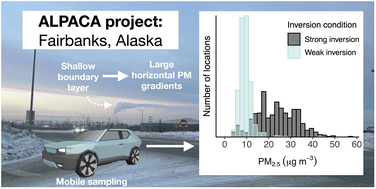Wintertime spatial patterns of particulate matter in Fairbanks, AK during ALPACA 2022†
Abstract
Fairbanks-North Star Borough (FNSB), Alaska perennially experiences some of the worst wintertime air quality in the United States. FNSB was designated as a “serious” nonattainment area by the U.S. Environmental Protection Agency in 2017 for excessive fine particulate matter (PM2.5) concentrations. The ALPACA (Alaskan Layered Pollution And Chemical Analysis) field campaign was established to understand the sources of air pollution, pollutant transformations, and the meteorological conditions contributing to FNSB's air quality problem. We performed on-road mobile sampling during ALPACA to identify and understand the spatial patterns of PM across the study domain, which contained multiple stationary field sites and regulatory measurement sites. Our measurements demonstrate the following: (1) both the between-neighborhood and within-neighborhood variations in PM2.5 concentrations and composition are large (>10 μg m−3). (2) Spatial variations of PM in Fairbanks are tightly connected to meteorological conditions; dramatic between-neighborhood differences exist during strong temperature inversion conditions, but are significantly reduced during weaker temperature inversions, where atmospheric conditions are more well mixed. (3) During strong inversion conditions, total PM2.5 and black carbon (BC) are tightly spatially correlated and have high absorption Ångstrom exponent values (AAE > 1.4), but are relatively uncorrelated during weak inversion conditions and have lower AAE. (4) PM2.5, BC, and total particle number (PN) concentrations decreased with increasing elevation, with the fall-off being more dramatic during strong temperature inversion conditions. (5) Mobile sampling reveals important air pollutant concentration differences between the multiple fixed sites of the ALPACA study, and demonstrates the utility of adding mobile sampling for understanding the spatial context of large urban air quality field campaigns. These results are important for understanding both the PM exposure for residents of FNSB and the spatial context of the ALPACA study.



 Please wait while we load your content...
Please wait while we load your content...